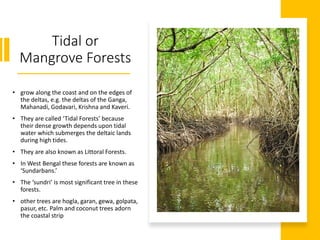naturalvegetationanditstypesinindia-211229191930.pdf
- 1. Natural Vegetation and its types in India
- 3. Natural Vegetation in India ŌĆó Tropical Evergreen Rain Forests ŌĆó Deciduous or Monsoon Type of Forests ŌĆó Dry Deciduous Forests and Scrubs ŌĆó Semi Desert and Desert Vegetation ŌĆó Tidal or Mangrove Forests and ŌĆó Mountain Forests Types:
- 4. Tropical Evergreen Rain Forests ŌĆó They grow in areas where rainfall is more than 200 cm. ŌĆó found on the slopes of the Western Ghats and the north-eastern regions of Arunachal Pradesh, ŌĆó Meghalaya, Assam, Nagaland, the Tarai areas of the Himalayas and the Andaman groups of Islands. ŌĆó trees in these forests never shed their leaves all. ŌĆó The trees have dense growth. ŌĆó trees are sisthu, chaplash, rosewood, mahogany, bamboos, garjan and sandal wood.
- 5. Deciduous or Monsoon type of Forests ŌĆó They are found in areas where the rainfall is between 100 cm and 200 cm. ŌĆó grow on the lower slope of the Himalayas, Assam, West Bengal, Bihar, Jharkhand, Orissa, Madhya Pradesh, Chhattishgarh, Maharashtra, Karnataka and the adjoining regions. ŌĆó Trees shed their leaves during dry-winter and dry-summer. ŌĆó Trees are teak, sal, sandal wood, deodar, bluegum, ebony, sisam, jack-fruit, mahua, palash, arjun, khair and bamboo.
- 6. Dry Deciduous Forests and Scrubs ŌĆó They grow in areas where the rainfall is between 50 cm and 100 cm ŌĆó found in areas of central Deccan plateau, south-east of Rajasthan, Punjab, Haryana and parts of Uttar Pradesh and Madhya Pradesh. ŌĆó Dwarf deciduous trees and long- grasses grow in these regions. ŌĆó Most of these areas are used for agriculture.
- 7. Semi-deserts and Deserts vegetation ŌĆó vegetation grow in areas where rainfall is less than 50 cm ŌĆó mostly thorny bushes, acacia, babul and sand binding grasses ŌĆó The Indian wild date, known as ŌĆ£KhejurŌĆØ is common in these deserts. ŌĆó They have long roots and thick fleshy stems in which they store water to survive during the long drought. ŌĆó found in Rajasthan and parts of Gujarat, Punjab and Karnataka.
- 8. Tidal or Mangrove Forests ŌĆó grow along the coast and on the edges of the deltas, e.g. the deltas of the Ganga, Mahanadi, Godavari, Krishna and Kaveri. ŌĆó They are called ŌĆśTidal ForestsŌĆÖ because their dense growth depends upon tidal water which submerges the deltaic lands during high tides. ŌĆó They are also known as Littoral Forests. ŌĆó In West Bengal these forests are known as ŌĆśSundarbans.ŌĆÖ ŌĆó The ŌĆśsundriŌĆÖ is most significant tree in these forests. ŌĆó other trees are hogla, garan, gewa, golpata, pasur, etc. Palm and coconut trees adorn the coastal strip
- 9. Mountain Forests ŌĆó They vary according to altitude with varying rainfall and temperature along the slopes of mountain. Himalayas up to a height of 1500 meters, evergreen trees, such as, sal, teak, bamboo and cane grow abundantly. ŌĆó It ranges between 1,500 meters to 3,500 meters, temperate conifer trees, such as, pine, fir, oak, maple, deodar, laurel, spruce and ceder. ŌĆó In higher altitude of the Himalayas, rhododendrons and junipers are found. Beyond these vegetation-belts, alpine grasslands appear up to snowfield.









